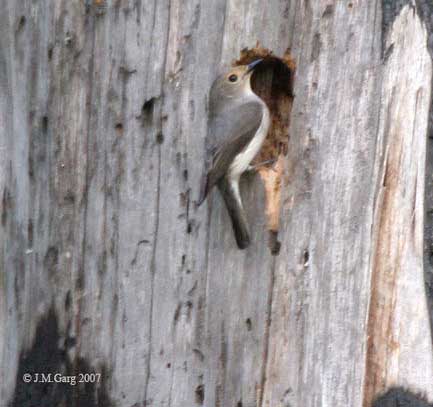
Ficedula superciliaris aestigma, female (*)
Superregnum: Eukaryota
Cladus: Unikonta
Cladus: Opisthokonta
Cladus: Holozoa
Regnum: Animalia
Subregnum: Eumetazoa
Cladus: Bilateria
Cladus: Nephrozoa
Superphylum: Deuterostomia
Phylum: Chordata
Subphylum: Vertebrata
Infraphylum: Gnathostomata
Megaclassis: Osteichthyes
Cladus: Sarcopterygii
Cladus: Rhipidistia
Cladus: Tetrapodomorpha
Cladus: Eotetrapodiformes
Cladus: Elpistostegalia
Superclassis: Tetrapoda
Cladus: Reptiliomorpha
Cladus: Amniota
Classis: Reptilia
Cladus: Eureptilia
Cladus: Romeriida
Subclassis: Diapsida
Cladus: Sauria
Infraclassis: Archosauromorpha
Cladus: Crurotarsi
Divisio: Archosauria
Cladus: Avemetatarsalia
Cladus: Ornithodira
Subtaxon: Dinosauromorpha
Cladus: Dinosauriformes
Cladus: Dracohors
Cladus: Dinosauria
Ordo: Saurischia
Cladus: Eusaurischia
Cladus: Theropoda
Cladus: Neotheropoda
Cladus: Averostra
Cladus: Tetanurae
Cladus: Avetheropoda
Cladus: Coelurosauria
Cladus: Tyrannoraptora
Cladus: Maniraptoromorpha
Cladus: Maniraptoriformes
Cladus: Maniraptora
Cladus: Pennaraptora
Cladus: Paraves
Cladus: Eumaniraptora
Cladus: Avialae
Infraclassis: Aves
Cladus: Euavialae
Cladus: Avebrevicauda
Cladus: Pygostylia
Cladus: Ornithothoraces
Cladus: Euornithes
Cladus: Ornithuromorpha
Cladus: Ornithurae
Cladus: Carinatae
Parvclassis: Neornithes
Cohors: Neognathae
Cladus: Neoaves
Cladus: Telluraves
Cladus: Australaves
Ordo: Passeriformes
Subordo: Passeri
Infraordo: Passerida
Superfamilia: Muscicapoidea
Familia: Muscicapidae
Genus: Ficedula
Species: Ficedula superciliaris
Subspecies: F. s. aestigma – F. s. superciliaris
Name
Ficedula superciliaris (Jerdon, 1840)
Ficedula superciliaris, male
References
Madras Journal of Literature and Science 11 (26): 16.
Vernacular names
Deutsch: Brauenschnäpper
English: Ultramarine Flycatcher
Esperanto: Bluflanka muŝkaptulo
español: Papamoscas ultramarino
मराठी: नीलसागर
Nederlands: Witkeelvliegenvanger
svenska: Ultramarinflugsnappare
中文: 白眉蓝姬鹟
The ultramarine flycatcher or the white-browed blue flycatcher (Ficedula superciliaris) is a small arboreal Old World flycatcher in the ficedula family that breeds in the foothills of the Himalayas and winters in southern India.
Description
Male
Somewhat smaller in size than a sparrow (ca. 10 cm) and with a stocky build. The male is deep blue above, sides of head and neck are deep blue, and a prominent white patch runs from centre of throat, through breast to belly. The amount of white on the brow and tail show clinal variation from West to East along the Himalayan foothills, which is sometimes taken to distinguish three subspecies:
The western subspecies from the western Himalayas has a distinctive white supercilium and white bases to the outer tail feathers.
The eastern subspecies (Ficedula superciliaris aestigma) from the eastern Himalayas lacks distinct white patches.
The population from the south Assam hills (sometimes designated a third subspecies cleta) completely lack any supercilium.
Usually singly, though sometimes in mixed hunting parties in the winter. Keeps largely to the low trees and bushes, feeding among the foliage canopy, not venturing much into the open. Constantly jerks up its tail, often accompanied by fluffing of head feathers and trrr note, especially in proximity of nest. Diet is mainly insects.
Distribution
Summer: Common breeding visitor to the western Himalayas, from Jammu and Kashmir and Himachal Pradesh to Uttarakhand (western race), and intergrading within Nepal with the eastern race Ficedula superciliaris aestigma which continues in the eastern Himalayas through Bhutan to Arunachal Pradesh. Breeding between 2000–2700 m, occasionally as low as 1800 and as high as 3200 m. Also in the lower hills of Meghalaya and Nagaland, Khasi and Cachar hills, sometimes considered a third race; winter movements of this population is not known.[2] Habitat: Open, mixed forests of oak, rhododendron, pine, fir, etc., occasionally orchards.
Winter: Central India from Delhi south to northern Maharashtra, Goa, northern Maharashtra, and eastward to Andhra Pradesh and Odisha. Wintering populations in the eastern states, possibly from Nepal/Sikkim, are mixed: a good part of this population also have white supercilium and basal tail patches (see description below). Also sometimes found as a vagrant in the northern part of Bangladesh.[3]
Nesting
Season: middle of April to early July
Nest: soft structure of fine moss with some strips of bark and fine grass, lined with hair and rootlets, place in holes or clefts in trees, at heights up to seven meters, or in a depression on a steep bank. Readily takes to nest boxes in hill station gardens.
Eggs: 3 to 5, usually 4, olive greenish to dull stone-buff, densely freckled all over with reddish brown, or in another type, mostly around the large end, forming a cap. Average size 16x12.2 mm.
Foraging Behavior
Typically they respond to indirect cues more than direct cues in relation to risk management when foraging for food.[4]
Gallery
Male from Himachal Pradesh, India
Female at Kullu - Manali District of Himachal Pradesh, India
Female at Sattal, India
References
BirdLife International (2020). "Ficedula superciliaris". IUCN Red List of Threatened Species. 2020: e.T22709406A181848930. doi:10.2305/IUCN.UK.2020-3.RLTS.T22709406A181848930.en. Retrieved 11 November 2021.
Ali, Salim; Sidney Dillon Ripley (2001) [1986]. Handbook of the Birds of India and Pakistan, 2nd ed.,10 vols (2nd ed.). New Delhi: Oxford University Press.Bird Number 1421-1422 (races F.s.superciliaris and F.s.aestigma), vol. 7, p. 166-168.
"Ultramarine Flycatcher (Ficedula superciliaris) :: xeno-canto". www.xeno-canto.org.
Fong, Tracy E. “The Importance of Indirect Cues for White-Browed Sparrow-Weaver ( Plocepasser Mahali) Risk Assessment.” Acta Ethologica, vol. 12, no. 2, 10 Jan. 2009, pp. 79–85. Ebscohost, white-browed sparrow-weaver.
Retrieved from "http://en.wikipedia.org/"
All text is available under the terms of the GNU Free Documentation License


